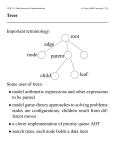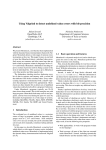Download Valgrind Documentation Set
Transcript
Valgrind Documentation Set
Development release 2.1.2 July 18 2004
Copyright © 2000-2004 ???
Permission is granted to copy, distribute and/or modify this document under the terms of the GNU Free Documentation
License, Version 1.1 or any later version published by the Free Software Foundation; with no Invariant Sections, with
no Front-Cover Texts, and with no Back-Cover Texts. A copy of the license is included in the section entitled ???.
Table of Contents
Valgrind User’s Manual . . . . . . . . . . . . . . . . . . . . . . . . . . . . . . . . . . . . . . . . . . . . . . . . . . . . . . . . . . . . . . . . . . . . . . . . . . . 1
1. Using and understanding the Valgrind core . . . . . . . . . . . . . . . . . . . . . . . . . . . . . . . . . . . . . . . . . . . . . . . . . . 1
What Valgrind does with your program . . . . . . . . . . . . . . . . . . . . . . . . . . . . . . . . . . . . . . . . . . . . . . . . . . 1
Getting started . . . . . . . . . . . . . . . . . . . . . . . . . . . . . . . . . . . . . . . . . . . . . . . . . . . . . . . . . . . . . . . . . . . . . . . . 1
The commentary . . . . . . . . . . . . . . . . . . . . . . . . . . . . . . . . . . . . . . . . . . . . . . . . . . . . . . . . . . . . . . . . . . . . . . 2
Reporting of errors . . . . . . . . . . . . . . . . . . . . . . . . . . . . . . . . . . . . . . . . . . . . . . . . . . . . . . . . . . . . . . . . . . . . 4
Suppressing errors . . . . . . . . . . . . . . . . . . . . . . . . . . . . . . . . . . . . . . . . . . . . . . . . . . . . . . . . . . . . . . . . . . . . . 4
Command-line flags for the Valgrind core . . . . . . . . . . . . . . . . . . . . . . . . . . . . . . . . . . . . . . . . . . . . . . . . 7
Tool-selection option . . . . . . . . . . . . . . . . . . . . . . . . . . . . . . . . . . . . . . . . . . . . . . . . . . . . . . . . . . . . . 7
Basic Options . . . . . . . . . . . . . . . . . . . . . . . . . . . . . . . . . . . . . . . . . . . . . . . . . . . . . . . . . . . . . . . . . . . . 8
Error-related options . . . . . . . . . . . . . . . . . . . . . . . . . . . . . . . . . . . . . . . . . . . . . . . . . . . . . . . . . . . . . 9
malloc()-related Options . . . . . . . . . . . . . . . . . . . . . . . . . . . . . . . . . . . . . . . . . . . . . . . . . . . . . . . . . 11
Rare Options . . . . . . . . . . . . . . . . . . . . . . . . . . . . . . . . . . . . . . . . . . . . . . . . . . . . . . . . . . . . . . . . . . . 12
Debugging Valgrind Options . . . . . . . . . . . . . . . . . . . . . . . . . . . . . . . . . . . . . . . . . . . . . . . . . . . . . 13
Setting default Options . . . . . . . . . . . . . . . . . . . . . . . . . . . . . . . . . . . . . . . . . . . . . . . . . . . . . . . . . . 14
The Client Request mechanism . . . . . . . . . . . . . . . . . . . . . . . . . . . . . . . . . . . . . . . . . . . . . . . . . . . . . . . . 15
Support for POSIX Pthreads . . . . . . . . . . . . . . . . . . . . . . . . . . . . . . . . . . . . . . . . . . . . . . . . . . . . . . . . . . . 17
Handling of Signals . . . . . . . . . . . . . . . . . . . . . . . . . . . . . . . . . . . . . . . . . . . . . . . . . . . . . . . . . . . . . . . . . . 18
Building and Installing . . . . . . . . . . . . . . . . . . . . . . . . . . . . . . . . . . . . . . . . . . . . . . . . . . . . . . . . . . . . . . . . 18
If You Have Problems . . . . . . . . . . . . . . . . . . . . . . . . . . . . . . . . . . . . . . . . . . . . . . . . . . . . . . . . . . . . . . . . . 18
Limitations . . . . . . . . . . . . . . . . . . . . . . . . . . . . . . . . . . . . . . . . . . . . . . . . . . . . . . . . . . . . . . . . . . . . . . . . . . 19
How It Works -- A Rough Overview . . . . . . . . . . . . . . . . . . . . . . . . . . . . . . . . . . . . . . . . . . . . . . . . . . . . 20
Getting started . . . . . . . . . . . . . . . . . . . . . . . . . . . . . . . . . . . . . . . . . . . . . . . . . . . . . . . . . . . . . . . . . . 20
The translation/instrumentation engine . . . . . . . . . . . . . . . . . . . . . . . . . . . . . . . . . . . . . . . . . . . . 21
Tracking the Status of Memory . . . . . . . . . . . . . . . . . . . . . . . . . . . . . . . . . . . . . . . . . . . . . . . . . . . 21
System calls . . . . . . . . . . . . . . . . . . . . . . . . . . . . . . . . . . . . . . . . . . . . . . . . . . . . . . . . . . . . . . . . . . . . 21
Signals . . . . . . . . . . . . . . . . . . . . . . . . . . . . . . . . . . . . . . . . . . . . . . . . . . . . . . . . . . . . . . . . . . . . . . . . 22
An Example Run . . . . . . . . . . . . . . . . . . . . . . . . . . . . . . . . . . . . . . . . . . . . . . . . . . . . . . . . . . . . . . . . . . . . . 22
Warning Messages You Might See . . . . . . . . . . . . . . . . . . . . . . . . . . . . . . . . . . . . . . . . . . . . . . . . . . . . . 23
ii
Valgrind User’s Manual
Valgrind User’s Manual
Table of Contents
1. Using and understanding the Valgrind core . . . . . . . . . . . . . . . . . . . . . . . . . . . . . . . . . . . . . . . . . . . . . . . . . . . . . . . 1
What Valgrind does with your program . . . . . . . . . . . . . . . . . . . . . . . . . . . . . . . . . . . . . . . . . . . . . . . . . . 1
Getting started . . . . . . . . . . . . . . . . . . . . . . . . . . . . . . . . . . . . . . . . . . . . . . . . . . . . . . . . . . . . . . . . . . . . . . . . 1
The commentary . . . . . . . . . . . . . . . . . . . . . . . . . . . . . . . . . . . . . . . . . . . . . . . . . . . . . . . . . . . . . . . . . . . . . . 2
Reporting of errors . . . . . . . . . . . . . . . . . . . . . . . . . . . . . . . . . . . . . . . . . . . . . . . . . . . . . . . . . . . . . . . . . . . . 4
Suppressing errors . . . . . . . . . . . . . . . . . . . . . . . . . . . . . . . . . . . . . . . . . . . . . . . . . . . . . . . . . . . . . . . . . . . . . 4
Command-line flags for the Valgrind core . . . . . . . . . . . . . . . . . . . . . . . . . . . . . . . . . . . . . . . . . . . . . . . . 7
Tool-selection option . . . . . . . . . . . . . . . . . . . . . . . . . . . . . . . . . . . . . . . . . . . . . . . . . . . . . . . . . . . . . 7
Basic Options . . . . . . . . . . . . . . . . . . . . . . . . . . . . . . . . . . . . . . . . . . . . . . . . . . . . . . . . . . . . . . . . . . . . 8
Error-related options . . . . . . . . . . . . . . . . . . . . . . . . . . . . . . . . . . . . . . . . . . . . . . . . . . . . . . . . . . . . . 9
malloc()-related Options . . . . . . . . . . . . . . . . . . . . . . . . . . . . . . . . . . . . . . . . . . . . . . . . . . . . . . . . . 11
Rare Options . . . . . . . . . . . . . . . . . . . . . . . . . . . . . . . . . . . . . . . . . . . . . . . . . . . . . . . . . . . . . . . . . . . 12
Debugging Valgrind Options . . . . . . . . . . . . . . . . . . . . . . . . . . . . . . . . . . . . . . . . . . . . . . . . . . . . . 13
Setting default Options . . . . . . . . . . . . . . . . . . . . . . . . . . . . . . . . . . . . . . . . . . . . . . . . . . . . . . . . . . 14
The Client Request mechanism . . . . . . . . . . . . . . . . . . . . . . . . . . . . . . . . . . . . . . . . . . . . . . . . . . . . . . . . 15
Support for POSIX Pthreads . . . . . . . . . . . . . . . . . . . . . . . . . . . . . . . . . . . . . . . . . . . . . . . . . . . . . . . . . . . 17
Handling of Signals . . . . . . . . . . . . . . . . . . . . . . . . . . . . . . . . . . . . . . . . . . . . . . . . . . . . . . . . . . . . . . . . . . 18
Building and Installing . . . . . . . . . . . . . . . . . . . . . . . . . . . . . . . . . . . . . . . . . . . . . . . . . . . . . . . . . . . . . . . . 18
If You Have Problems . . . . . . . . . . . . . . . . . . . . . . . . . . . . . . . . . . . . . . . . . . . . . . . . . . . . . . . . . . . . . . . . . 18
Limitations . . . . . . . . . . . . . . . . . . . . . . . . . . . . . . . . . . . . . . . . . . . . . . . . . . . . . . . . . . . . . . . . . . . . . . . . . . 19
How It Works -- A Rough Overview . . . . . . . . . . . . . . . . . . . . . . . . . . . . . . . . . . . . . . . . . . . . . . . . . . . . 20
Getting started . . . . . . . . . . . . . . . . . . . . . . . . . . . . . . . . . . . . . . . . . . . . . . . . . . . . . . . . . . . . . . . . . . 20
The translation/instrumentation engine . . . . . . . . . . . . . . . . . . . . . . . . . . . . . . . . . . . . . . . . . . . . 21
Tracking the Status of Memory . . . . . . . . . . . . . . . . . . . . . . . . . . . . . . . . . . . . . . . . . . . . . . . . . . . 21
System calls . . . . . . . . . . . . . . . . . . . . . . . . . . . . . . . . . . . . . . . . . . . . . . . . . . . . . . . . . . . . . . . . . . . . 21
Signals . . . . . . . . . . . . . . . . . . . . . . . . . . . . . . . . . . . . . . . . . . . . . . . . . . . . . . . . . . . . . . . . . . . . . . . . 22
An Example Run . . . . . . . . . . . . . . . . . . . . . . . . . . . . . . . . . . . . . . . . . . . . . . . . . . . . . . . . . . . . . . . . . . . . . 22
Warning Messages You Might See . . . . . . . . . . . . . . . . . . . . . . . . . . . . . . . . . . . . . . . . . . . . . . . . . . . . . 23
iii
Chapter 1. Using and understanding the
Valgrind core
This section describes the Valgrind core services, flags and behaviours. That means it is relevant regardless of what
particular tool you are using. A point of terminology: most references to "valgrind" in the rest of this section (Section
2) refer to the valgrind core services.
What Valgrind does with your program
Valgrind is designed to be as non-intrusive as possible. It works directly with existing executables. You don’t need to
recompile, relink, or otherwise modify, the program to be checked.
Simply put valgrind --tool=tool_name at the start of the command line normally used to run the program.
For example, if want to run the command ls -l using the heavyweight memory-checking tool Memcheck, issue the
command:
valgrind --tool=memcheck ls -l
Regardless of which tool is in use, Valgrind takes control of your program before it starts. Debugging information is
read from the executable and associated libraries, so that error messages and other outputs can be phrased in terms of
source computeroutput locations (if that is appropriate).
Your program is then run on a synthetic x86 CPU provided by the Valgrind core. As new computeroutput is executed
for the first time, the core hands the computeroutput to the selected tool. The tool adds its own instrumentation
computeroutput to this and hands the result back to the core, which coordinates the continued execution of this
instrumented computeroutput.
The amount of instrumentation computeroutput added varies widely between tools.
At one end of the scale,
Memcheck adds computeroutput to check every memory access and every value computed, increasing the size of
the computeroutput at least 12 times, and making it run 25-50 times slower than natively. At the other end of the
spectrum, the ultra-trivial "none" tool (a.k.a. Nulgrind) adds no instrumentation at all and causes in total "only" about
a 4 times slowdown.
Valgrind simulates every single instruction your program executes. Because of this, the active tool checks, or profiles,
not only the computeroutput in your application but also in all supporting dynamically-linked (.so-format) libraries,
including the GNU C library, the X client libraries, Qt, if you work with KDE, and so on.
If you’re using one of the error-detection tools, Valgrind will often detect errors in libraries, for example the GNU C
or X11 libraries, which you have to use. You might not be interested in these errors, since you probably have noo
control over that computeroutput. Therefore, Valgrind allows you to selectively suppress errors, by recording them in
a suppressions file which is read when Valgrind starts up. The build mechanism attempts to select suppressions which
give reasonable behaviour for the libc and XFree86 versions detected on your machine. To make it easier to write
suppressions, you can use the --gen-suppressions=yes option which tells Valgrind to print out a suppression
for each error that appears, which you can then copy into a suppressions file.
Different error-checking tools report different kinds of errors. The suppression mechanism therefore allows you to
say which tool or tool(s) each suppression applies to.
Getting started
1
Using and
understanding the
Valgrind core
First off, consider whether it might be beneficial to recompile your application and supporting libraries with debugging
info enabled (the -g flag). Without debugging info, the best Valgrind tools will be able to do is guess which function
a particular piece of computeroutput belongs to, which makes both error messages and profiling output nearly useless.
With -g, you’ll hopefully get messages which point directly to the relevant source computeroutput lines.
Another flag you might like to consider, if you are working with C++, is -fno-inline. That makes it easier to see
the function-call chain, which can help reduce confusion when navigating around large C++ apps. For whatever it’s
worth, debugging OpenOffice.org with Memcheck is a bit easier when using this flag.
You don’t have to do this, but doing so helps Valgrind produce more accurate and less confusing error reports. Chances
are you’re set up like this already, if you intended to debug your program with GNU gdb, or some other debugger.
This paragraph applies only if you plan to use Memcheck: On rare occasions, optimisation levels at -O2 and above
have been observed to generate computeroutput which fools Memcheck into wrongly reporting uninitialised value
errors. We have looked in detail into fixing this, and unfortunately the result is that doing so would give a further
significant slowdown in what is already a slow tool. So the best solution is to turn off optimisation altogether. Since
this often makes things unmanagably slow, a plausible compromise is to use -O. This gets you the majority of the
benefits of higher optimisation levels whilst keeping relatively small the chances of false complaints from Memcheck.
All other tools (as far as we know) are unaffected by optimisation level.
Valgrind understands both the older "stabs" debugging format, used by gcc versions prior to 3.1, and the newer
DWARF2 format used by gcc 3.1 and later. We continue to refine and debug our debug-info readers, although
the majority of effort will naturally enough go into the newer DWARF2 reader.
When you’re ready to roll, just run your application as you would normally, but place valgrind
--tool=tool_name in front of your usual command-line invocation.
Note that you should run the real
(machine-computeroutput) executable here. If your application is started by, for example, a shell or perl script,
you’ll need to modify it to invoke Valgrind on the real executables. Running such scripts directly under Valgrind
will result in you getting error reports pertaining to /bin/sh, /usr/bin/perl, or whatever interpreter you’re
using.
This may not be what you want and can be confusing.
You can force the issue by giving the flag
--trace-children=yes, but confusion is still likely.
The commentary
Valgrind tools write a commentary, a stream of text, detailing error reports and other significant events. All lines in
the commentary have following form:
==12345== some-message-from-Valgrind
The 12345 is the process ID. This scheme makes it easy to distinguish program output from Valgrind commentary,
and also easy to differentiate commentaries from different processes which have become merged together, for whatever
reason.
By default, Valgrind tools write only essential messages to the commentary, so as to avoid flooding you with
information of secondary importance. If you want more information about what is happening, re-run, passing the -v
flag to Valgrind.
You can direct the commentary to three different places:
2
Using and
understanding the
Valgrind core
1.
The default: send it to a file descriptor, which is by default 2 (stderr). So, if you give the core no options, it will
write commentary to the standard error stream. If you want to send it to some other file descriptor, for example
number 9, you can specify --log-fd=9.
2.
A less intrusive option is to write the commentary to a file, which you specify by --log-file=filename.
Note carefully that the commentary is not written to the file you specify, but instead to one called
filename.pid12345, if for example the pid of the traced process is 12345.
This is helpful when
valgrinding a whole tree of processes at once, since it means that each process writes to its own logfile, rather
than the result being jumbled up in one big logfile.
3.
The least intrusive option is to send the commentary to a network socket. The socket is specified as an IP address
and port number pair, like this: --log-socket=192.168.0.1:12345 if you want to send the output to
host IP 192.168.0.1 port 12345 (I have no idea if 12345 is a port of pre-existing significance). You can also omit
the port number: --log-socket=192.168.0.1, in which case a default port of 1500 is used. This default
is defined by the constant VG_CLO_DEFAULT_LOGPORT in the sources.
Note, unfortunately, that you have to use an IP address here, rather than a hostname.
Writing to a network socket is pretty useless if you don’t have something listening at the other end. We provide
a simple listener program, valgrind-listener, which accepts connections on the specified port and copies
whatever it is sent to stdout. Probably someone will tell us this is a horrible security risk. It seems likely that
people will write more sophisticated listeners in the fullness of time.
valgrind-listener can accept simultaneous connections from up to 50 valgrinded processes. In front of each line
of output it prints the current number of active connections in round brackets.
valgrind-listener accepts two command-line flags:
•
-e or --exit-at-zero: when the number of connected processes falls back to zero, exit. Without this, it
will run forever, that is, until you send it Control-C.
•
portnumber: changes the port it listens on from the default (1500). The specified port must be in the range
1024 to 65535. The same restriction applies to port numbers specified by a --log-socket= to Valgrind
itself.
If a valgrinded process fails to connect to a listener, for whatever reason (the listener isn’t running, invalid or
unreachable host or port, etc), Valgrind switches back to writing the commentary to stderr. The same goes for
any process which loses an established connection to a listener. In other words, killing the listener doesn’t kill
the processes sending data to it.
3
Using and
understanding the
Valgrind core
Here is an important point about the relationship between the commentary and profiling output from tools. The
commentary contains a mix of messages from the Valgrind core and the selected tool. If the tool reports errors, it will
report them to the commentary. However, if the tool does profiling, the profile data will be written to a file of some
kind, depending on the tool, and independent of what --log-* options are in force. The commentary is intended
to be a low-bandwidth, human-readable channel. Profiling data, on the other hand, is usually voluminous and not
meaningful without further processing, which is why we have chosen this arrangement.
Reporting of errors
When one of the error-checking tools (Memcheck, Addrcheck, Helgrind) detects something bad happening in the
program, an error message is written to the commentary. For example:
==25832== Invalid read of size 4
==25832==
at 0x8048724: BandMatrix::ReSize(int, int, int) (bogon.cpp:45)
==25832==
by 0x80487AF: main (bogon.cpp:66)
==25832==
by 0x40371E5E: __libc_start_main (libc-start.c:129)
==25832==
by 0x80485D1: (within /home/sewardj/newmat10/bogon)
==25832==
Address 0xBFFFF74C is not stack’d, malloc’d or free’d
This message says that the program did an illegal 4-byte read of address 0xBFFFF74C, which, as far as Memcheck
can tell, is not a valid stack address, nor corresponds to any currently malloc’d or free’d blocks. The read is happening
at line 45 of bogon.cpp, called from line 66 of the same file, etc.
For errors associated with an identified
malloc’d/free’d block, for example reading free’d memory, Valgrind reports not only the location where the error
happened, but also where the associated block was malloc’d/free’d.
Valgrind remembers all error reports. When an error is detected, it is compared against old reports, to see if it is a
duplicate. If so, the error is noted, but no further commentary is emitted. This avoids you being swamped with
bazillions of duplicate error reports.
If you want to know how many times each error occurred, run with the -v option. When execution finishes, all the
reports are printed out, along with, and sorted by, their occurrence counts. This makes it easy to see which errors have
occurred most frequently.
Errors are reported before the associated operation actually happens. If you’re using a tool (Memcheck, Addrcheck)
which does address checking, and your program attempts to read from address zero, the tool will emit a message to
this effect, and the program will then duly die with a segmentation fault.
In general, you should try and fix errors in the order that they are reported. Not doing so can be confusing. For
example, a program which copies uninitialised values to several memory locations, and later uses them, will generate
several error messages, when run on Memcheck. The first such error message may well give the most direct clue to
the root cause of the problem.
The process of detecting duplicate errors is quite an expensive one and can become a significant performance overhead
if your program generates huge quantities of errors. To avoid serious problems here, Valgrind will simply stop
collecting errors after 300 different errors have been seen, or 30000 errors in total have been seen. In this situation
you might as well stop your program and fix it, because Valgrind won’t tell you anything else useful after this. Note
that the 300/30000 limits apply after suppressed errors are removed. These limits are defined in vg_include.h
and can be increased if necessary.
To avoid this cutoff you can use the --error-limit=no flag. Then Valgrind will always show errors, regardless
of how many there are. Use this flag carefully, since it may have a dire effect on performance.
4
Using and
understanding the
Valgrind core
Suppressing errors
The error-checking tools detect numerous problems in the base libraries, such as the GNU C library, and the XFree86
client libraries, which come pre-installed on your GNU/Linux system. You can’t easily fix these, but you don’t want
to see these errors (and yes, there are many!) So Valgrind reads a list of errors to suppress at startup. A default
suppression file is cooked up by the ./configure script when the system is built.
You can modify and add to the suppressions file at your leisure, or, better, write your own. Multiple suppression files
are allowed. This is useful if part of your project contains errors you can’t or don’t want to fix, yet you don’t want to
continuously be reminded of them.
Note: By far the easiest way to add suppressions is to use the --gen-suppressions=yes flag described in
Command-line flags for the Valgrind core [7].
Each error to be suppressed is described very specifically, to minimise the possibility that a suppression-directive
inadvertantly suppresses a bunch of similar errors which you did want to see. The suppression mechanism is designed
to allow precise yet flexible specification of errors to suppress.
If you use the -v flag, at the end of execution, Valgrind prints out one line for each used suppression, giving its name
and the number of times it got used. Here’s the suppressions used by a run of valgrind --tool=memcheck
ls -l:
--27579-- supp: 1←socketcall.connect(serv_addr)/__libc_connect/__nscd_getgrgid_r
--27579-- supp: 1←socketcall.connect(serv_addr)/__libc_connect/__nscd_getpwuid_r
--27579-- supp: 6 strrchr/_dl_map_object_from_fd/_dl_map_object
Multiple suppressions files are allowed. By default, Valgrind uses $PREFIX/lib/valgrind/default.supp.
You can ask to add suppressions from another file, by specifying --suppressions=/path/to/file.supp.
If you want to understand more about suppressions, look at an existing suppressions file whilst reading the following
documentation. The file glibc-2.2.supp, in the source distribution, provides some good examples.
Each suppression has the following components:
•
First line: its name. This merely gives a handy name to the suppression, by which it is referred to in the summary
of used suppressions printed out when a program finishes. It’s not important what the name is; any identifying
string will do.
5
Using and
understanding the
Valgrind core
•
Second line: name of the tool(s) that the suppression is for (if more than one, comma-separated), and the name of
the suppression itself, separated by a colon (Nb: no spaces are allowed), eg:
tool_name1,tool_name2:suppression_name
Recall that Valgrind-2.0.X is a modular system, in which different instrumentation tools can observe your program
whilst it is running. Since different tools detect different kinds of errors, it is necessary to say which tool(s) the
suppression is meaningful to.
Tools will complain, at startup, if a tool does not understand any suppression directed to it.
Tools ignore
suppressions which are not directed to them. As a result, it is quite practical to put suppressions for all tools
into the same suppression file.
Valgrind’s core can detect certain PThreads API errors, for which this line reads:
core:PThread
•
Next line: a small number of suppression types have extra information after the second line (eg. the Param
suppression for Memcheck)
•
Remaining lines: This is the calling context for the error -- the chain of function calls that led to it. There can be
up to four of these lines.
Locations may be either names of shared objects/executables or wildcards matching function names. They begin
obj: and fun: respectively. Function and object names to match against may use the wildcard characters *
and ?.
Important note: C++ function names must be mangled. If you are writing suppressions by hand, use the
--demangle=no option to get the mangled names in your error messages.
•
Finally, the entire suppression must be between curly braces. Each brace must be the first character on its own line.
A suppression only suppresses an error when the error matches all the details in the suppression. Here’s an example:
{
__gconv_transform_ascii_internal/__mbrtowc/mbtowc
Memcheck:Value4
fun:__gconv_transform_ascii_internal
fun:__mbr*toc
fun:mbtowc
}
What it means is: for Memcheck only, suppress a use-of-uninitialised-value error, when the data size
is 4, when it occurs in the function __gconv_transform_ascii_internal, when that is called
6
Using and
understanding the
Valgrind core
from any function of name matching __mbr*toc, when that is called from mbtowc.
It doesn’t apply under any other circumstances.
The string by which this suppression is identified to the user is
__gconv_transform_ascii_internal/__mbrtowc/mbtowc.
(See ??? for more details on the specifics of Memcheck’s suppression kinds.)
Another example, again for the Memcheck tool:
{
libX11.so.6.2/libX11.so.6.2/libXaw.so.7.0
Memcheck:Value4
obj:/usr/X11R6/lib/libX11.so.6.2
obj:/usr/X11R6/lib/libX11.so.6.2
obj:/usr/X11R6/lib/libXaw.so.7.0
}
Suppress any size 4 uninitialised-value error which occurs anywhere in libX11.so.6.2, when called from
anywhere in the same library, when called from anywhere in libXaw.so.7.0. The inexact specification of
locations is regrettable, but is about all you can hope for, given that the X11 libraries shipped with Red Hat 7.2 have
had their symbol tables removed.
Note: since the above two examples did not make it clear, you can freely mix the obj: and fun: styles of description
within a single suppression record.
Command-line flags for the Valgrind core
As mentioned above, Valgrind’s core accepts a common set of flags. The tools also accept tool-specific flags, which
are documented seperately for each tool.
You invoke Valgrind like this:
valgrind --tool=tool_name [valgrind-options] your-prog [your-prog options]
Valgrind’s default settings succeed in giving reasonable behaviour in most cases. We group the available options by
rough categories.
Tool-selection option
The single most important option.
•
--tool=name
Run the Valgrind tool called name, e.g. Memcheck, Addrcheck, Cachegrind, etc.
7
Using and
understanding the
Valgrind core
Basic Options
These options work with all tools.
•
--help
Show help for all options, both for the core and for the selected tool.
•
--help-debug
Same as --help, but also lists debugging options which usually are only of use to developers.
•
--version
Show the version number of the Valgrind core. Tools can have their own version numbers. There is a scheme in
place to ensure that tools only execute when the core version is one they are known to work with. This was done
to minimise the chances of strange problems arising from tool-vs-core version incompatibilities.
•
-v --verbose
Be more verbose. Gives extra information on various aspects of your program, such as: the shared objects loaded,
the suppressions used, the progress of the instrumentation and execution engines, and warnings about unusual
behaviour. Repeating the flag increases the verbosity level.
•
-q --quiet
Run silently, and only print error messages.
automated test machinery.
Useful if you are running regression tests or have some other
•
--trace-children=no [default]
--trace-children=yes
When enabled, Valgrind will trace into child processes. This is confusing and usually not what you want, so is
disabled by default.
•
--log-fd=<number> [default: 2, stderr]
Specifies that Valgrind should send all of its messages to the specified file descriptor. The default, 2, is the
standard error channel (stderr). Note that this may interfere with the client’s own use of stderr.
•
--log-file=<filename>
Specifies that Valgrind should send all of its messages to the specified file. In fact, the file name used is created
by concatenating the text filename, ".pid" and the process ID, so as to create a file per process. The specified
file name may not be the empty string.
8
Using and
understanding the
Valgrind core
•
--log-socket=<ip-address:port-number>
Specifies that Valgrind should send all of its messages to the specified port at the specified IP address. The port
may be omitted, in which case port 1500 is used. If a connection cannot be made to the specified socket, Valgrind
falls back to writing output to the standard error (stderr). This option is intended to be used in conjunction with
the valgrind-listener program. For further details, see The commentary [2].
Error-related options
These options are used by all tools that can report errors, e.g. Memcheck, but not Cachegrind.
•
--demangle=no
--demangle=yes [default]
Disable/enable automatic demangling (decoding) of C++ names. Enabled by default. When enabled, Valgrind
will attempt to translate encomputeroutputd C++ procedure names back to something approaching the original.
The demangler handles symbols mangled by g++ versions 2.X and 3.X.
An important fact about demangling is that function names mentioned in suppressions files should be in their
mangled form. Valgrind does not demangle function names when searching for applicable suppressions, because
to do otherwise would make suppressions file contents dependent on the state of Valgrind’s demangling machinery,
and would also be slow and pointless.
•
--num-callers=<number> [default=4]
By default, Valgrind shows four levels of function call names to help you identify program locations. You can
change that number with this option. This can help in determining the program’s location in deeply-nested call
chains. Note that errors are commoned up using only the top three function locations (the place in the current
function, and that of its two immediate callers). So this doesn’t affect the total number of errors reported.
The maximum value for this is 50. Note that higher settings will make Valgrind run a bit more slowly and take a
bit more memory, but can be useful when working with programs with deeply-nested call chains.
•
--error-limit=yes [default]
--error-limit=no
When enabled, Valgrind stops reporting errors after 30000 in total, or 300 different ones, have been seen. This is
to stop the error tracking machinery from becoming a huge performance overhead in programs with many errors.
•
--show-below-main=yes
--show-below-main=no [default]
By default, stack traces for errors do not show any functions that appear beneath main(); most of the time it’s
uninteresting C library stuff. If this option is enabled, these entries below main() will be shown.
9
Using and
understanding the
Valgrind core
•
--suppressions=<filename> [default: $PREFIX/lib/valgrind/default.supp]
Specifies an extra file from which to read descriptions of errors to suppress.
suppressions files as you like.
You may use as many extra
•
--gen-suppressions=no [default]
--gen-suppressions=yes
When enabled, Valgrind will pause after every error shown, and print the line: ---- Print suppression
?
--- [Return/N/n/Y/y/C/c] ---The prompt’s behaviour is the same as for the --db-attach option.
If you choose to, Valgrind will print out a suppression for this error. You can then cut and paste it into a suppression
file if you don’t want to hear about the error in the future.
This option is particularly useful with C++ programs, as it prints out the suppressions with mangled names, as
required.
Note that the suppressions printed are as specific as possible. You may want to common up similar ones, eg. by
adding wildcards to function names. Also, sometimes two different errors are suppressed by the same suppression,
in which case Valgrind will output the suppression more than once, but you only need to have one copy in your
suppression file (but having more than one won’t cause problems). Also, the suppression name is given as
<insert a suppression name here>; the name doesn’t really matter, it’s only used with the -v option
which prints out all used suppression records.
•
--track-fds=no [default]
--track-fds=yes
When enabled, Valgrind will print out a list of open file descriptors on exit. Along with each file descriptor,
Valgrind prints out a stack backtrace of where the file was opened and any details relating to the file descriptor
such as the file name or socket details.
•
--db-attach=no [default]
--db-attach=yes
When enabled, Valgrind will pause after every error shown, and print the line: ---- Attach to debugger
? --- [Return/N/n/Y/y/C/c] ---Pressing Ret, or N Ret or n Ret, causes Valgrind not to start a debugger for this error.
Y Ret or y Ret causes Valgrind to start a debugger, for the program at this point. When you have finished with
the debugger, quit from it, and the program will continue. Trying to continue from inside the debugger doesn’t
work.
C Ret or c Ret causes Valgrind not to start a debugger, and not to ask again.
Note: --db-attach=yes conflicts with --trace-children=yes. You can’t use them together. Valgrind
refuses to start up in this situation.
10
Using and
understanding the
Valgrind core
1 May 2002: this is a historical relic which could be easily fixed if it gets in your way. Mail me and complain if
this is a problem for you.
Nov 2002: if you’re sending output to a logfile or to a network socket, I guess this option doesn’t make any sense.
Caveat emptor.
•
--db-command=<command> [default: gdb -nw %f %p]
This specifies how Valgrind will invoke the debugger. By default it will use whatever GDB is detected at build
time, which is usually /usr/bin/gdb. Using this command, you can specify some alternative command to
invoke the debugger you want to use.
The command string given can include one or instances of the %p and %f expansions. Each instance of %p expands
to the PID of the process to be debugged and each instance of %f expands to the path to the executable for the
process to be debugged.
•
--input-fd=<number> [default=0, stdin]
When using --db-attach=yes and --gen-suppressions=yes, Valgrind will stop so as to read keyboard
input from you, when each error occurs. By default it reads from the standard input (stdin), which is problematic
for programs which close stdin. This option allows you to specify an alternative file descriptor from which to read
input.
malloc()-related Options
For tools that use their own version of malloc() (e.g. Memcheck and Addrcheck), the following options apply.
•
--alignment=<number> [default: 8]
By default Valgrind’s malloc, realloc, etc, return 4-byte aligned addresses. These are suitable for any
accesses on x86 processors. Some programs might however assume that malloc et al return 8- or more aligned
memory. The supplied value must be between 4 and 4096 inclusive, and must be a power of two.
•
--sloppy-malloc=no [default]
--sloppy-malloc=yes
When enabled, all requests for malloc/calloc are rounded up to a whole number of machine words -- in other words,
made divisible by 4. For example, a request for 17 bytes of space would result in a 20-byte area being made
available. This works around bugs in sloppy libraries which assume that they can safely rely on malloc/calloc
requests being rounded up in this fashion. Without the workaround, these libraries tend to generate large numbers
of errors when they access the ends of these areas.
Valgrind snapshots dated 17 Feb 2002 and later are cleverer about this problem, and you should no longer need
to use this flag. To put it bluntly, if you do need to use this flag, your program violates the ANSI C semantics
defined for malloc and free, even if it appears to work correctly, and you should fix it, at least if you hope for
maximum portability.
11
Using and
understanding the
Valgrind core
Rare Options
These options apply to all tools, as they affect certain obscure workings of the Valgrind core. Most people won’t need
to use these.
•
--run-libc-freeres=yes [default]
--run-libc-freeres=no
The GNU C library (libc.so), which is used by all programs, may allocate memory for its own uses. Usually
it doesn’t bother to free that memory when the program ends - there would be no point, since the Linux kernel
reclaims all process resources when a process exits anyway, so it would just slow things down.
The glibc authors realised that this behaviour causes leak checkers, such as Valgrind, to falsely report leaks in
glibc, when a leak check is done at exit. In order to avoid this, they provided a routine called __libc_freeres
specifically to make glibc release all memory it has allocated. Memcheck and Addrcheck therefore try and run
__libc_freeres at exit.
Unfortunately, in some versions of glibc, __libc_freeres is sufficiently buggy to cause segmentation
faults. This is particularly noticeable on Red Hat 7.1. So this flag is provided in order to inhibit the run
of __libc_freeres. If your program seems to run fine on Valgrind, but segfaults at exit, you may find
that --run-libc-freeres=no fixes that, although at the cost of possibly falsely reporting space leaks in
libc.so.
•
--weird-hacks=hack1,hack2,...
Pass miscellaneous hints to Valgrind which slightly modify the simulated behaviour in nonstandard or dangerous
ways, possibly to help the simulation of strange features. By default no hacks are enabled. Use with caution!
Currently known hacks are:
•
lax-ioctls
Be very lax about ioctl handling; the only assumption is that the size is correct. Doesn’t require the full buffer
to be initialized when writing. Without this, using some device drivers with a large number of strange ioctl
commands becomes very tiresome.
•
--signal-polltime=<time> [default=50]
How often to poll for signals (in milliseconds). Only applies for older kernels that need signal routing.
•
--lowlat-signals=no [default]
--lowlat-signals=yes
Improve wake-up latency when a thread receives a signal.
12
Using and
understanding the
Valgrind core
•
--lowlat-syscalls=no [default]
--lowlat-syscalls=yes
Improve wake-up latency when a thread’s syscall completes.
Debugging Valgrind Options
There are also some options for debugging Valgrind itself.
things. Nevertheless:
You shouldn’t need to use them in the normal run of
•
--single-step=no [default]
--single-step=yes
When enabled, each x86 insn is translated separately into instrumented computeroutput.
translation is done on a per-basic-block basis, giving much better translations.
When disabled,
•
--optimise=no
--optimise=yes [default]
When enabled, various improvements are applied to the intermediate computeroutput, mainly aimed at allowing
the simulated CPU’s registers to be cached in the real CPU’s registers over several simulated instructions.
•
--profile=no
--profile=yes [default]
When enabled, does crude internal profiling of Valgrind itself. This is not for profiling your programs. Rather it
is to allow the developers to assess where Valgrind is spending its time. The tools must be built for profiling for
this to work.
•
--trace-syscalls=no [default]
--trace-syscalls=yes
Enable/disable tracing of system call intercepts.
•
--trace-signals=no [default]
--trace-signals=yes
Enable/disable tracing of signal handling.
13
Using and
understanding the
Valgrind core
•
--trace-sched=no [default]
--trace-sched=yes
Enable/disable tracing of thread scheduling events.
•
--trace-pthread=none [default]
--trace-pthread=some
--trace-pthread=all
Specifies amount of trace detail for pthread-related events.
•
--trace-symtab=no [default]
--trace-symtab=yes
Enable/disable tracing of symbol table reading.
•
--trace-malloc=no [default]
--trace-malloc=yes
Enable/disable tracing of malloc/free (et al) intercepts.
•
--trace-computeroutputgen=XXXXX [default: 00000]
Enable/disable tracing of computeroutput generation. Computeroutput can be printed at five different stages of
translation; each X element must be 0 or 1.
•
--dump-error=<number> [default: inactive]
After the program has exited, show gory details of the translation of the basic block containing the <number>’th
error context. When used with --single-step=yes, can show the exact x86 instruction causing an error.
This is all fairly dodgy and doesn’t work at all if threads are involved.
Setting default Options
Note that Valgrind also reads options from three places:
1.
The file ~/.valgrindrc
2.
The environment variable $VALGRIND_OPTS
3.
The file ./.valgrindrc
14
Using and
understanding the
Valgrind core
These are processed in the given order, before the command-line options. Options processed later override those
processed earlier; for example, options in ./.valgrindrc will take precedence over those in ~/.valgrindrc.
The first two are particularly useful for setting the default tool to use.
Any tool-specific options put in $VALGRIND_OPTS or the .valgrindrc files should be prefixed with the tool
name and a colon. For example, if you want Memcheck to always do leak checking, you can put the following entry
in ~/.valgrindrc:
--memcheck:leak-check=yes
This will be ignored if any tool other than Memcheck is run. Without the memcheck: part, this will cause problems
if you select other tools that don’t understand --leak-check=yes.
The Client Request mechanism
Valgrind has a trapdoor mechanism via which the client program can pass all manner of requests and queries to
Valgrind and the current tool. Internally, this is used extensively to make malloc, free, signals, threads, etc, work,
although you don’t see that.
For your convenience, a subset of these so-called client requests is provided to allow you to tell Valgrind facts about
the behaviour of your program, and conversely to make queries. In particular, your program can tell Valgrind about
changes in memory range permissions that Valgrind would not otherwise know about, and so allows clients to get
Valgrind to do arbitrary custom checks.
Clients need to include a header file to make this work. Which header file depends on which client requests you
use. Some client requests are handled by the core, and are defined in the header file valgrind.h. Tool-specific
header files are named after the tool, e.g. memcheck.h. All header files can be found in the include directory of
wherever Valgrind was installed.
The macros in these header files have the magical property that they generate computeroutput in-line which Valgrind
can spot. However, the computeroutput does nothing when not run on Valgrind, so you are not forced to run your
program on Valgrind just because you use the macros in this file. Also, you are not required to link your program
with any extra supporting libraries.
Here is a brief description of the macros available in valgrind.h, which work with more than one tool (see the
tool-specific documentation for explanations of the tool-specific macros).
* 0.60+1em
* 0.60+1em RUNNING_ON_VALGRIND:
returns 1 if running on Valgrind, 0 if running on the real
CPU.
15
Using and
understanding the
Valgrind core
* 0.60+1em VALGRIND_DISCARD_TRANSLATIONS:
discard translations of computeroutput in the specified address range. Useful if you are debugging a JITter or some
other dynamic computeroutput generation system. After
this call, attempts to execute computeroutput in the invalidated address range will cause Valgrind to make new
translations of that computeroutput, which is probably the
semantics you want. Note that this is implemented naively, and involves checking all 200191 entries in the translation table to see if any of them overlap the specified address range. So try not to call it often, or performance
will nosedive. Note that you can be clever about this:
you only need to call it when an area which previously
contained computeroutput is overwritten with new computeroutput. You can choose to write computeroutput
into fresh memory, and just call this occasionally to discard large chunks of old computeroutput all at once.
Warning: minimally tested, especially for tools other
than Memcheck.
* 0.60+1em VALGRIND_COUNT_ERRORS:
returns the number of errors found so far by Valgrind. Can
be useful in test harness computeroutput when combined
with the --log-fd=-1 option; this runs Valgrind silently, but the client program can detect when errors occur.
Only useful for tools that report errors, e.g. it’s useful for
Memcheck, but for Cachegrind it will always return zero
because Cachegrind doesn’t report errors.
* 0.60+1em VALGRIND_MALLOCLIKE_BLOCK:
If your program manages its own memory instead of
using the standard malloc() / new / new[], tools that
track information about heap blocks will not do nearly
as good a job. For example, Memcheck won’t detect
nearly as many errors, and the error messages won’t be
as informative.
To improve this situation, use this
macro just after your custom allocator allocates some
new memory. See the comments in valgrind.h for
information on how to use it.
* 0.60+1em VALGRIND_FREELIKE_BLOCK:
This should be used in conjunction with
VALGRIND_MALLOCLIKE_BLOCK.
Again,
see
memcheck/memcheck.h for information on how to
use it.
* 0.60+1em VALGRIND_CREATE_MEMPOOL:
This is similar to VALGRIND_MALLOCLIKE_BLOCK,
but is tailored towards computeroutput that uses memory
pools. See the comments in valgrind.h for information on how to use it.
16
Using and
understanding the
Valgrind core
* 0.60+1em VALGRIND_DESTROY_MEMPOOL:
This should be used in conjunction with
VALGRIND_CREATE_MEMPOOL Again, see the
comments in valgrind.h for information on how to
use it.
* 0.60+1em VALGRIND_MEMPOOL_ALLOC:
This should be used in conjunction with
VALGRIND_CREATE_MEMPOOL Again, see the
comments in valgrind.h for information on how to
use it.
* 0.60+1em VALGRIND_MEMPOOL_FREE:
This should be used in conjunction with
VALGRIND_CREATE_MEMPOOL Again, see the
comments in valgrind.h for information on how to
use it.
* 0.60+1em VALGRIND_NON_SIMD_CALL[0123]:
executes a function of 0, 1, 2 or 3 args in the client program on the real CPU, not the virtual CPU that Valgrind
normally runs computeroutput on. These are used in various ways internally to Valgrind. They might be useful
to client programs.
Warning: Only use these if you really know what you are
doing.
* 0.60+1em VALGRIND_PRINTF(format, ...):
printf a message to the log file when running under Valgrind. Nothing is output if not running under Valgrind.
Returns the number of characters output.
* 0.60+1em VALGRIND_PRINTF_BACKTRACE(format, ...):
printf a message to the log file along with a stack backtrace when running under Valgrind. Nothing is output
if not running under Valgrind. Returns the number of
characters output.
Note that valgrind.h is included by all the tool-specific header files (such as memcheck.h), so you don’t need to
include it in your client if you include a tool-specific header.
Support for POSIX Pthreads
Valgrind supports programs which use POSIX pthreads. Getting this to work was technically challenging but it all
works well enough for significant threaded applications to work.
It works as follows: threaded apps are (dynamically) linked against libpthread.so. Usually this is the one
installed with your Linux distribution. Valgrind, however, supplies its own libpthread.so and automatically
connects your program to it instead.
The fake libpthread.so and Valgrind cooperate to implement a user-space pthreads package. This approach
avoids the horrible implementation problems of implementing a truly multiprocessor version of Valgrind, but it does
mean that threaded apps run only on one CPU, even if you have a multiprocessor machine.
17
Using and
understanding the
Valgrind core
Valgrind schedules your threads in a round-robin fashion, with all threads having equal priority. It switches threads
every 50000 basic blocks (typically around 300000 x86 instructions), which means you’ll get a much finer interleaving
of thread executions than when run natively. This in itself may cause your program to behave differently if you have
some kind of concurrency, critical race, locking, or similar, bugs.
As of the Valgrind-1.0 release, the state of pthread support was as follows:
•
Mutexes, condition variables, thread-specific data, pthread_once, reader-writer locks, semaphores, cleanup
stacks, cancellation and thread detaching currently work. Various attribute-like calls are handled but ignored; you
get a warning message.
•
Currently the following syscalls are thread-safe (nonblocking): write, read, nanosleep, sleep, select,
poll, recvmsg and accept.
•
Signals in pthreads are now handled properly(ish): pthread_sigmask, pthread_kill, sigwait and
raise are now implemented. Each thread has its own signal mask, as POSIX requires. It’s a bit kludgey
-- there’s a system-wide pending signal set, rather than one for each thread. But hey.
Note: As of 18 May 2002, the following threaded programs now work fine on my RedHat 7.2 box: Opera 6.0Beta2,
KNode in KDE 3.0, Mozilla-0.9.2.1 and Galeon-0.11.3, both as supplied with RedHat 7.2. Also Mozilla 1.0RC2.
OpenOffice 1.0. MySQL 3.something (the current stable release).
Handling of Signals
Valgrind provides suitable handling of signals, so, provided you stick to POSIX stuff, you should be ok. Basic
sigaction() and sigprocmask() are handled. Signal handlers may return in the normal way or do longjmp(); both
should work ok. As specified by POSIX, a signal is blocked in its own handler. Default actions for signals should
work as before. Etc, etc.
Under the hood, dealing with signals is a real pain, and Valgrind’s simulation leaves much to be desired. If your
program does way-strange stuff with signals, bad things may happen. If so, let us know. We don’t promise to fix it,
but we’d at least like to be aware of it.
Building and Installing
We use the standard Unix ./configure, make, make install mechanism, and we have attempted to ensure
that it works on machines with kernel 2.2 or 2.4 and glibc 2.1.X or 2.2.X. I don’t think there is much else to say. There
are no options apart from the usual --prefix that you should give to ./configure.
The configure script tests the version of the X server currently indicated by the current $DISPLAY. This is a
known bug. The intention was to detect the version of the current XFree86 client libraries, so that correct suppressions
could be selected for them, but instead the test checks the server version. This is just plain wrong.
If you are building a binary package of Valgrind for distribution, please read README_PACKAGERS ???. It contains
some important information.
Apart from that, there’s not much excitement here. Let us know if you have build problems.
If You Have Problems
18
Using and
understanding the
Valgrind core
Contact us at http://www.valgrind.org.
See Limitations [19] for the known limitations of Valgrind, and for a list of programs which are known not to work on
it.
The translator/instrumentor has a lot of assertions in it. They are permanently enabled, and I have no plans to disable
them. If one of these breaks, please mail us!
If you get an assertion failure on the expression chunkSane(ch) in vg_free() in vg_malloc.c, this may
have happened because your program wrote off the end of a malloc’d block, or before its beginning. Valgrind should
have emitted a proper message to that effect before dying in this way. This is a known problem which we should fix.
Read the FAQ ??? for more advice about common problems, crashes, etc.
Limitations
The following list of limitations seems depressingly long. However, most programs actually work fine.
Valgrind will run x86-GNU/Linux ELF dynamically linked binaries, on a kernel 2.2.X or 2.4.X system, subject to the
following constraints:
•
No support for 3DNow instructions. If the translator encounters these, Valgrind will generate a SIGILL when the
instruction is executed.
•
Pthreads support is improving, but there are still significant limitations in that department. See the section above
on Pthreads. Note that your program must be dynamically linked against libpthread.so, so that Valgrind
can substitute its own implementation at program startup time. If you’re statically linked against it, things will
fail badly.
•
Memcheck assumes that the floating point registers are not used as intermediaries in memory-to-memory copies,
so it immediately checks definedness of values loaded from memory by floating-point loads. If you want to
write computeroutput which copies around possibly-uninitialised values, you must ensure these travel through the
integer registers, not the FPU.
•
If your program does its own memory management, rather than using malloc/new/free/delete, it should still work,
but Valgrind’s error checking won’t be so effective. If you describe your program’s memory management scheme
using "client requests" (Section 3.7 of this manual), Memcheck can do better. Nevertheless, using malloc/new
and free/delete is still the best approach.
•
Valgrind’s signal simulation is not as robust as it could be. Basic POSIX-compliant sigaction and sigprocmask
functionality is supplied, but it’s conceivable that things could go badly awry if you do weird things with signals.
Workaround: don’t. Programs that do non-POSIX signal tricks are in any case inherently unportable, so should
be avoided if possible.
•
Programs which switch stacks are not well handled. Valgrind does have support for this, but I don’t have great
faith in it. It’s difficult -- there’s no cast-iron way to decide whether a large change in %esp is as a result of the
program switching stacks, or merely allocating a large object temporarily on the current stack -- yet Valgrind needs
to handle the two situations differently.
19
Using and
understanding the
Valgrind core
•
x86 instructions, and system calls, have been implemented on demand. So it’s possible, although unlikely, that a
program will fall over with a message to that effect. If this happens, please report ALL the details printed out, so
we can try and implement the missing feature.
•
x86 floating point works correctly, but floating-point computeroutput may run even more slowly than integer
computeroutput, due to my simplistic approach to FPU emulation.
•
Memory consumption of your program is majorly increased whilst running under Valgrind. This is due to the large
amount of administrative information maintained behind the scenes. Another cause is that Valgrind dynamically
translates the original executable. Translated, instrumented computeroutput is 14-16 times larger than the original
(!) so you can easily end up with 30+ MB of translations when running (eg) a web browser.
Programs which are known not to work are:
•
emacs starts up but immediately concludes it is out of memory and aborts.
Emacs has it’s own memorymanagement scheme, but I don’t understand why this should interact so badly with Valgrind. Emacs works
fine if you build it to use the standard malloc/free routines.
Known platform-specific limitations, as of release 1.0.0:
•
On Red Hat 7.3, there have been reports of link errors (at program start time) for threaded programs
using __pthread_clock_gettime and __pthread_clock_settime. This appears to be due to
/lib/librt-2.2.5.so needing them. Unfortunately I do not understand enough about this problem to fix it
properly, and I can’t reproduce it on my test RedHat 7.3 system. Please mail me if you have more information /
understanding.
How It Works -- A Rough Overview
Some gory details, for those with a passion for gory details. You don’t need to read this section if all you want to do is
use Valgrind. What follows is an outline of the machinery. A more detailed (and somewhat out of date) description
is to be found ???.
Getting started
Valgrind is compiled into a shared object, valgrind.so. The shell script valgrind sets the LD_PRELOAD environment
variable to point to valgrind.so. This causes the .so to be loaded as an extra library to any subsequently executed
dynamically-linked ELF binary, viz, the program you want to debug.
The dynamic linker allows each .so in the process image to have an initialisation function which is run before main().
It also allows each .so to have a finalisation function run after main() exits.
When valgrind.so’s initialisation function is called by the dynamic linker, the synthetic CPU to starts up. The real CPU
remains locked in valgrind.so for the entire rest of the program, but the synthetic CPU returns from the initialisation
function. Startup of the program now continues as usual -- the dynamic linker calls all the other .so’s initialisation
routines, and eventually runs main(). This all runs on the synthetic CPU, not the real one, but the client program
cannot tell the difference.
20
Using and
understanding the
Valgrind core
Eventually main() exits, so the synthetic CPU calls valgrind.so’s finalisation function. Valgrind detects this, and uses
it as its cue to exit. It prints summaries of all errors detected, possibly checks for memory leaks, and then exits
the finalisation routine, but now on the real CPU. The synthetic CPU has now lost control -- permanently -- so the
program exits back to the OS on the real CPU, just as it would have done anyway.
On entry, Valgrind switches stacks, so it runs on its own stack. On exit, it switches back. This means that the client
program continues to run on its own stack, so we can switch back and forth between running it on the simulated and
real CPUs without difficulty. This was an important design decision, because it makes it easy (well, significantly less
difficult) to debug the synthetic CPU.
The translation/instrumentation engine
Valgrind does not directly run any of the original program’s computeroutput. Only instrumented translations are
run. Valgrind maintains a translation table, which allows it to find the translation quickly for any branch target
(computeroutput address). If no translation has yet been made, the translator - a just-in-time translator - is summoned.
This makes an instrumented translation, which is added to the collection of translations. Subsequent jumps to that
address will use this translation.
Valgrind no longer directly supports detection of self-modifying computeroutput.
Such checking is expensive,
and in practice (fortunately) almost no applications need it. However, to help people who are debugging dynamic
computeroutput generation systems, there is a Client Request (basically a macro you can put in your program) which
directs Valgrind to discard translations in a given address range. So Valgrind can still work in this situation provided
the client tells it when computeroutput has become out-of-date and needs to be retranslated.
The JITter translates basic blocks -- blocks of straight-line-computeroutput -- as single entities. To minimise the
considerable difficulties of dealing with the x86 instruction set, x86 instructions are first translated to a RISC-like
intermediate computeroutput, similar to sparc computeroutput, but with an infinite number of virtual integer registers.
Initially each insn is translated seperately, and there is no attempt at instrumentation.
The intermediate computeroutput is improved, mostly so as to try and cache the simulated machine’s registers in the
real machine’s registers over several simulated instructions. This is often very effective. Also, we try to remove
redundant updates of the simulated machines’s condition-computeroutput register.
The intermediate computeroutput is then instrumented, giving more intermediate computeroutput.
There are a
few extra intermediate-computeroutput operations to support instrumentation; it is all refreshingly simple. After
instrumentation there is a cleanup pass to remove redundant value checks.
This gives instrumented intermediate computeroutput which mentions arbitrary numbers of virtual registers. A linearscan register allocator is used to assign real registers and possibly generate spill computeroutput. All of this is still
phrased in terms of the intermediate computeroutput. This machinery is inspired by the work of Reuben Thomas
(Mite).
Then, and only then, is the final x86 computeroutput emitted. The intermediate computeroutput is carefully designed
so that x86 computeroutput can be generated from it without need for spare registers or other inconveniences.
The translations are managed using a traditional LRU-based caching scheme. The translation cache has a default size
of about 14MB.
Tracking the Status of Memory
Each byte in the process’ address space has nine bits associated with it: one A bit and eight V bits. The A and V bits
for each byte are stored using a sparse array, which flexibly and efficiently covers arbitrary parts of the 32-bit address
space without imposing significant space or performance overheads for the parts of the address space never visited. The
scheme used, and speedup hacks, are described in detail at the top of the source file coregrind/vg_memory.c,
so you should read that for the gory details.
21
Using and
understanding the
Valgrind core
System calls
All system calls are intercepted. The memory status map is consulted before and updated after each call. It’s all
rather tiresome. See coregrind/vg_syscalls.c for details.
Signals
All system calls to sigaction() and sigprocmask() are intercepted. If the client program is trying to set a signal handler,
Valgrind makes a note of the handler address and which signal it is for. Valgrind then arranges for the same signal to
be delivered to its own handler.
When such a signal arrives, Valgrind’s own handler catches it, and notes the fact. At a convenient safe point in
execution, Valgrind builds a signal delivery frame on the client’s stack and runs its handler. If the handler longjmp()s,
there is nothing more to be said. If the handler returns, Valgrind notices this, zaps the delivery frame, and carries on
where it left off before delivering the signal.
The purpose of this nonsense is that setting signal handlers essentially amounts to giving callback addresses to the
Linux kernel. We can’t allow this to happen, because if it did, signal handlers would run on the real CPU, not the
simulated one. This means the checking machinery would not operate during the handler run, and, worse, memory
permissions maps would not be updated, which could cause spurious error reports once the handler had returned.
An even worse thing would happen if the signal handler longjmp’d rather than returned: Valgrind would completely
lose control of the client program.
Upshot: we can’t allow the client to install signal handlers directly. Instead, Valgrind must catch, on behalf of the
client, any signal the client asks to catch, and must delivery it to the client on the simulated CPU, not the real one.
This involves considerable gruesome fakery; see coregrind/vg_signals.c for details.
An Example Run
This is the log for a run of a small program using Memcheck The program is in fact correct, and the reported error is
as the result of a potentially serious computeroutput generation bug in GNU g++ (snapshot 20010527).
sewardj@phoenix:~/newmat10$
~/Valgrind-6/valgrind -v ./bogon
==25832== Valgrind 0.10, a memory error detector for x86 RedHat 7.1.
==25832== Copyright (C) 2000-2001, and GNU GPL’d, by Julian Seward.
==25832== Startup, with flags:
==25832== --suppressions=/home/sewardj/Valgrind/redhat71.supp
==25832== reading syms from /lib/ld-linux.so.2
==25832== reading syms from /lib/libc.so.6
==25832== reading syms from /mnt/pima/jrs/Inst/lib/libgcc_s.so.0
==25832== reading syms from /lib/libm.so.6
==25832== reading syms from /mnt/pima/jrs/Inst/lib/libstdc++.so.3
==25832== reading syms from /home/sewardj/Valgrind/valgrind.so
==25832== reading syms from /proc/self/exe
==25832== loaded 5950 symbols, 142333 line number locations
==25832==
==25832== Invalid read of size 4
==25832==
at 0x8048724: _ZN10BandMatrix6ReSizeEiii (bogon.cpp:45)
==25832==
by 0x80487AF: main (bogon.cpp:66)
==25832==
by 0x40371E5E: __libc_start_main (libc-start.c:129)
==25832==
by 0x80485D1: (within /home/sewardj/newmat10/bogon)
22
Using and
understanding the
Valgrind core
==25832==
==25832==
==25832==
==25832==
==25832==
==25832==
==25832==
==25832==
==25832==
Address 0xBFFFF74C is not stack’d, malloc’d or free’d
ERROR SUMMARY: 1 errors from 1 contexts (suppressed: 0 from 0)
malloc/free: in use at exit: 0 bytes in 0 blocks.
malloc/free: 0 allocs, 0 frees, 0 bytes allocated.
For a detailed leak analysis, rerun with: --leak-check=yes
exiting, did 1881 basic blocks, 0 misses.
223 translations, 3626 bytes in, 56801 bytes out.
The GCC folks fixed this about a week before gcc-3.0 shipped.
Warning Messages You Might See
Most of these only appear if you run in verbose mode (enabled by -v):
•
More than 50 errors detected. Subsequent errors will still be recorded,
but in less detail than before.
After 50 different errors have been shown, Valgrind becomes more conservative about collecting them. It then
requires only the program counters in the top two stack frames to match when deciding whether or not two errors
are really the same one. Prior to this point, the PCs in the top four frames are required to match. This hack
has the effect of slowing down the appearance of new errors after the first 50. The 50 constant can be changed by
recompiling Valgrind.
•
More than 300 errors detected.
error counts may be inaccurate.
I’m not reporting any more.
Go fix your program!
Final
After 300 different errors have been detected, Valgrind ignores any more. It seems unlikely that collecting even
more different ones would be of practical help to anybody, and it avoids the danger that Valgrind spends more
and more of its time comparing new errors against an ever-growing collection. As above, the 300 number is a
compile-time constant.
•
Warning:
client switching stacks?
Valgrind spotted such a large change in the stack pointer, %esp, that it guesses the client is switching to a different
stack. At this point it makes a kludgey guess where the base of the new stack is, and sets memory permissions
accordingly. You may get many bogus error messages following this, if Valgrind guesses wrong. At the moment
"large change" is defined as a change of more that 2000000 in the value of the %esp (stack pointer) register.
•
Warning:
client attempted to close Valgrind’s logfile fd <number>
Valgrind doesn’t allow the client to close the logfile, because you’d never see any diagnostic information after that
point. If you see this message, you may want to use the --log-fd=<number> option to specify a different
logfile file-descriptor number.
23
Using and
understanding the
Valgrind core
•
Warning:
noted but unhandled ioctl <number>
Valgrind observed a call to one of the vast family of ioctl system calls, but did not modify its memory status
info (because I have not yet got round to it). The call will still have gone through, but you may get spurious errors
after this as a result of the non-update of the memory info.
•
Warning:
set address range perms:
large range <number>
Diagnostic message, mostly for benefit of the valgrind developers, to do with memory permissions.
24














































